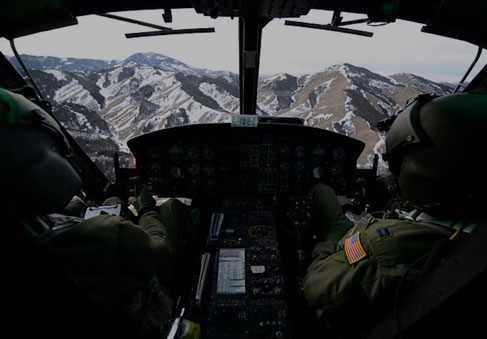A comprehensive altitude-illness prevention and management program is a command responsibility. All high-altitude illnesses are related to sustained hypoxia (inadequate oxygen) and can be treated by raising oxygen levels in the body tissues. The preferred management for all high-altitude illnesses is evacuation to a lower altitude.
Background
The term “high altitude” refers to terrestrial elevations over 13,123 ft (4,000 m), but it is commonly divided into three categories: high—7,874 to 13,123 ft (2,400 to 4,000 m); very high—13,123 to 18,045 ft (4,000 to 5,500 m); and extreme—18,045 ft (above 5,500 m). A low-pressure, low-oxygen exposure (hypobaric hypoxia) is an environmental stress that results from ascending to high altitude. Each increase in altitude is accompanied by a decrease in atmospheric barometric pressure and a proportional decrease in the partial pressure of oxygen. Ultimately, the oxygen partial pressure falls to levels that cause measurable physiological changes in physical and cognitive performance and, potentially, the emergence of altitude illness. Rapid ascent of unacclimatized persons from low altitude to extreme altitude is likely to result in rapid incapacitation and a high probability of developing fatal altitude illness. The U.S. Army’s TB MED 505 provides important information regarding successful management of altitude illness. Management and prevention depend on proper education and the experience of leaders and troops during exposure to altitude.
Myths and Claims
It is commonly believed that physical fitness can prevent acute mountain sickness. The principal control for preventing altitude illness is adequate acclimatization to the environment.
Facts
Acute mountain sickness (AMS) refers to a constellation of symptoms in the context of recent ascent to altitude. Symptoms include headache; anorexia, nausea, or vomiting; fatigue or weakness; dizziness or lightheadedness; and difficulty sleeping. Symptoms typically occur six to 12 hours after arrival at a new altitude (but may occur sooner) and resolve over one to three days, assuming no further ascent. AMS is unusual at altitudes below 8,202 ft (2,500 m). Severity of AMS can be quantified by using the Lake Louise scoring system (see Appendix F in TB Med 505). A score of three or more with a headache is diagnostic of AMS. Resting at the altitude attained often relieves the symptoms, and most people will improve without any other treatment if they reside at the same altitude for 24 to 48 hours. Acetazolamide, a carbonic anhydrase inhibitor, is effective in reducing the symptoms of AMS, although the optimum dosage is unknown; current recommendations of 250 mg every eight hours are widely published and have been shown to be effective. If acetazolamide is used, treatment should be started at least one day before ascent and continued until adequate acclimatization is judged to have occurred. Dexamethasone (8 mg initially, then 4 mg every six hours) may also be used to relieve symptoms. Both acetazolamide and dexamethasone must be used only with a doctor’s prescription and supervision.
High-altitude cerebral edema (HACE) is usually preceded by AMS and may lead to coma and death. Headache, nausea, vomiting, hallucination, disorientation, and confusion are often seen. Lack of muscle coordination, or ataxia, is a common clinical sign/feature that is often the last sign to disappear during recovery. Immediate descent is required for treatment. Dexamethasone and furosemide are the most widely accepted pharmacological treatment for HACE; as noted above, they must be used only with a doctor’s prescription and supervision.
High-altitude pulmonary edema (HAPE) occurs most commonly two to three days after arrival at altitude and consists of dyspnea (difficulty breathing) with exercise, progressing to dyspnea at rest, a dry cough, weakness, chest tightness or congestion, and poor exercise tolerance. Patients with HAPE tend to have lower oxygen saturations than unaffected people at the same altitude, but the degree of desaturation itself is not a reliable sign of HAPE. The incidence of HAPE is 0.0001% at around 8,858 ft (2,700 m), increasing to 2% at about 13,123ft (4,000 m). Speed of ascent, exercise during or immediately after ascent, sex (males are more susceptible), youth, and individual susceptibility are all risk factors. Descent is the primary treatment, and a descent of even a few hundred meters may be beneficial. Supplemental oxygen should be given if available. Nifedipine can also be effective in preventing and treating HAPE in susceptible individuals (10 mg orally initially, then 20 mg slow-release preparation every 12 hours), but it also requires a doctor’s prescription.
High-altitude retinal hemorrhage is patchy bleeding from the retinal blood vessels at high altitude. With increasing altitude, a precipitous drop in ocular oxygenation occurs. As the level of oxygenation decreases, retinal arteries and veins dilate to permit an increase in retinal blood flow. High-altitude retinal hemorrhages occur in up to 30% of people at 13,999 ft (4,267 m), 50 to 60% at 17,998 ft (5,486 m), and probably in 100% above 22,309 ft (6,800 m). High-altitude retinal hemorrhages may be more common in those with AMS. Descent is necessary when the hemorrhage occurs inside the macula (the visual center of the retina).
Cautions
Substances with significant diuretic properties, such as alcoholic beverages, caffeine, and diuretic medications, can be a problem at high altitude, as the body’s fluid content is already compromised, and dehydration due to decreased fluid intake and fluid losses is common.
Summary for Military Relevance
Medical problems when operating in high mountain environments can be caused by sustained exposure to low-pressure and low-oxygen conditions (hypobaric hypoxia). Problems caused by sustained low-pressure and low-oxygen exposures are unique to high altitudes, and medical personnel may be unfamiliar with approaches to treat altitude symptoms. All personnel need to be educated about the steps required to minimize the risk of altitude illness, which include hydration, nutrition, rest, and avoidance of intense physical activity as well as alcohol, drugs, and/or other forms of substance abuse. Medics and combat lifesavers should know how to recognize, minimize, manage, and treat altitude illness as well as implement measures to reduce the risk of additional illnesses. For more information about how to avoid altitude illness, see “Altitude Preexposure Recommendations for Inducing Acclimatization."





